
Honeysuckles are arching shrubs or twining vines in the family Caprifoliaceae, native to northern latitudes in North America and Eurasia. Approximately 180 species of honeysuckle have been identified in North America and Eurasia. Widely known species include Lonicera periclymenum, Lonicera japonica and Lonicera sempervirens. L. japonica is an aggressive, highly invasive species considered a significant pest on the continents of North America, Europe, South America, Australia, and Africa.

Lonicera morrowii, the Morrow's honeysuckle, is a deciduous honeysuckle in the family Caprifoliaceae, native to Japan, Korea, and Northeast China. It is a shrub, reaching a height of 2–2.5 m, with oblong leaves 4–6 cm long. It leafs out quite early in the spring, and in North America is commonly the first deciduous shrub with foliage in March. The flowers are white to pale yellow, and the fruit is a dark red berry 7–8 mm diameter containing numerous seeds. The berries, while eaten frequently by birds, are considered poisonous to humans. It is colloquially called "bush honeysuckle" in the United States, and is considered an invasive species.

Lonicera japonica, known as Japanese honeysuckle and golden-and-silver honeysuckle, is a species of honeysuckle native to eastern Asia. It is often grown as an ornamental plant, but has become an invasive species in a number of countries. Japanese honeysuckle is used in traditional Chinese medicine.
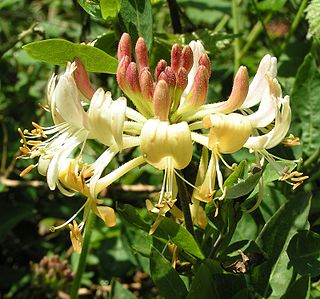
Lonicera periclymenum, common names honeysuckle, common honeysuckle, European honeysuckle, or woodbine, is a species of flowering plant in the family Caprifoliaceae native to much of Europe, North Africa, Turkey and the Caucasus. It is found as far north as southern Norway and Sweden.

Lonicera caerulea, also known by its common names blue honeysuckle, sweetberry honeysuckle, fly honeysuckle, blue-berried honeysuckle, or the honeyberry, is a non-climbing honeysuckle native throughout the cool temperate Northern Hemisphere in countries such as Canada, Japan, Russia, and Poland.

Lonicera involucrata, the bearberry honeysuckle, bracted honeysuckle, twinberry honeysuckle, Californian Honeysuckle, twin-berry, or black twinberry, is a species of honeysuckle native to northern and western North America.
Fly honeysuckle is a common name for several plants and may refer to:

The perennial vine Lonicera hispidula is a species of honeysuckle known as pink honeysuckle and, less often, California honeysuckle. It is a low-elevation woodlands shrub or vine found on the West Coast of North America.
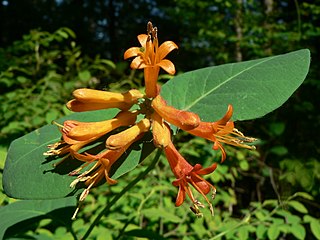
Lonicera ciliosa, the orange honeysuckle or western trumpet honeysuckle is a honeysuckle native to forests of western North America. A deciduous shrub growing to 6 m (20 ft) tall with hollow twigs, the leaves are opposite, oval, 4–10 cm (1.6–3.9 in) long with the last pair on each twig merged to form a disk. The flowers are orange-yellow, 2–4 cm (0.79–1.57 in) long, with five lobes and trumpet shaped; they are produced in whorls above the disk-leaf on the ends of shoots. The fruit is a translucent orange-red berry less than 1 cm (0.39 in) diameter.

Lonicera xylosteum, commonly known as fly honeysuckle, European fly honeysuckle, dwarf honeysuckle or fly woodbine is a deciduous shrub.

Lonicera sempervirens is a species of honeysuckle vine native to the eastern United States which is known for its reddish flowers.

Lonicera × heckrottii, the golden flame honeysuckle, is a plant in the honeysuckle family, Caprifoliaceae, grown in gardens for its showy flowers and long season of bloom.

Richard Otto Maack was a 19th-century Russian naturalist, geographer, and anthropologist. He is most known for his exploration of the Russian Far East and Siberia, particularly the Ussuri and Amur River valleys. He wrote some of the first scientific descriptions of the natural history of remote Siberia and collected many biological specimens, many of which were original type specimens of previously unknown species.

Lonicera tatarica is a species of honeysuckle known by the common name Tatarian honeysuckle. It is native to Siberia and other parts of eastern Asia Lonicera tatarica is also known to grow in the Himalayas, however it is better known in North America as a widespread introduced species and noxious weed. Honeysuckles are native to temperate zones of both hemispheres. This plant, one of several exotic bush honeysuckles present in North America, was introduced as an ornamental plant in 1752. It is known across the continent west to Alaska and California, where it easily grows in disturbed habitat.

Diervilla lonicera, commonly referred to as northern bush honeysuckle, low bush honeysuckle, dwarf bush honeysuckle, or yellow-flowered upright honeysuckle, is a deciduous shrub native to the northeastern United States and Canada. Its specific epithet, lonicera refers to its similarity in appearance to the true honeysuckles, genus Lonicera. It attracts bumblebees and is an important source of nectar for them.
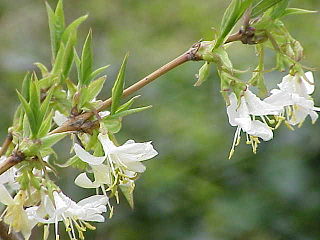
Lonicera fragrantissima is a species of flowering plant in the honeysuckle family Caprifoliaceae, known by the common names winter-flowering honeysuckle, fragrant honeysuckle, kiss-me-at-the-gate, and sweet breath of spring. It is native to China and has been an introduced species to other parts of the world. It was brought to the attention of western gardeners by Scottish plant hunter Robert Fortune, who was plant hunting in China for the Royal Horticultural Society. Fortune introduced Lonicera fragrantissima to England in 1845, and a few years later it was introduced to the United States. In 1853 the editor of American gardening magazine The Horticulturist wrote that the previous year he had been sent a specimen from a plant that had been flowering in the gardens of Hatfield House, the Marquess of Salisbury's stately home in Hertfordshire. The first mention of a specimen for commercial sale in an American plant catalogue is in 1860.
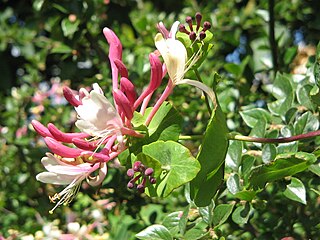
Lonicera caprifolium, the Italian woodbine, perfoliate honeysuckle, goat-leaf honeysuckle, Italian honeysuckle, or perfoliate woodbine, is a species of perennial flowering plants in the genus Lonicera of the family Caprifoliaceae. It is native to parts of Europe, and naturalised in South East Britain and northeastern North America. It can readily be distinguished from Europe's most common species, Lonicera periclymenum, by its topmost leaves, which are perfoliate as the Latin name suggests. It is a vigorous, deciduous climber growing up to 8 metres. It bears masses of very fragrant, cream-coloured flowers, tinged with pink, appearing in midsummer.

Lonicera dioica is a vine in the honeysuckle family native to Canada and the eastern and central United States. Lonicera dioica comprises four variations: var. Dasygyna, var. Dioica, var. Douglasii, and var. Orientalis.

Lonicera × bella, known as Bell's honeysuckle and showy fly honeysuckle, is a hybrid species of flowering plant in the family Caprifoliaceae. It was first described by Hermann Zabel in 1889. Zabel reported that he grew it in cultivation from seeds obtained from a plant of Lonicera morrowii, but that its appearance suggested the influence of L. tatarica. It has escaped from cultivation and become an aggressive invasive species in central and eastern parts of the United States.
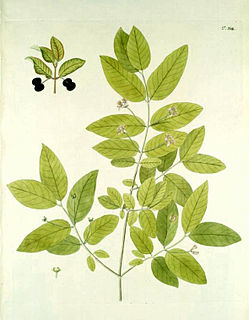
Lonicera nigra, known in English as black-berried honeysuckle is a bush honeysuckle native to the mountains of central and southern Europe.


















